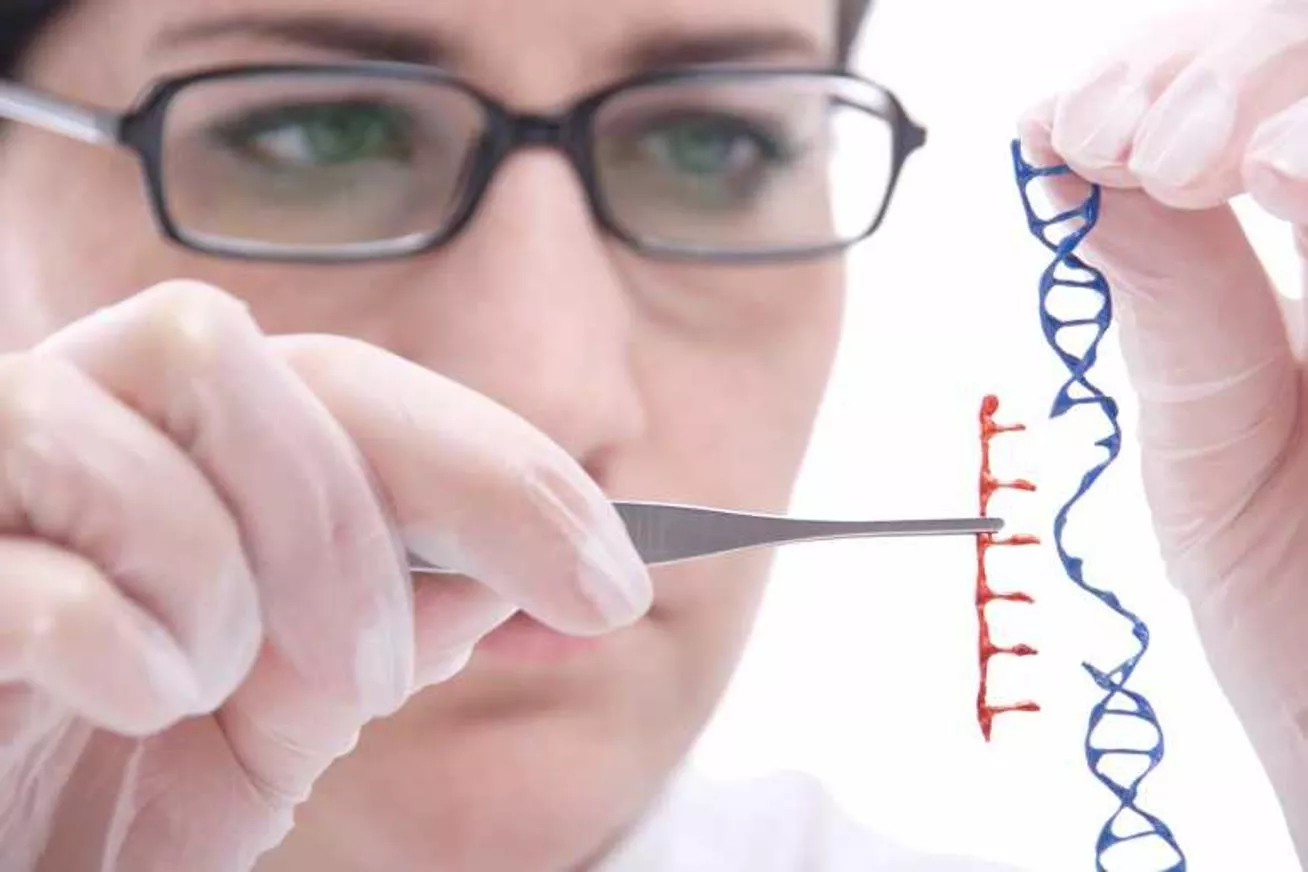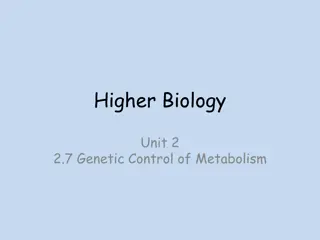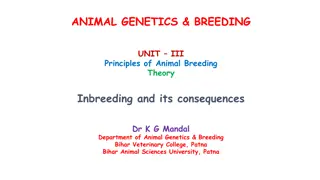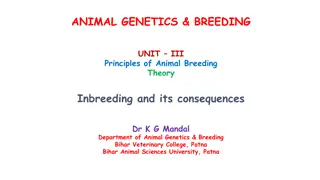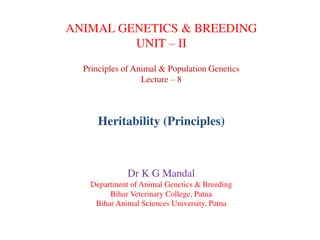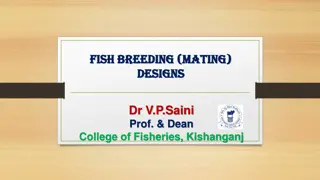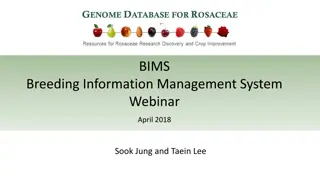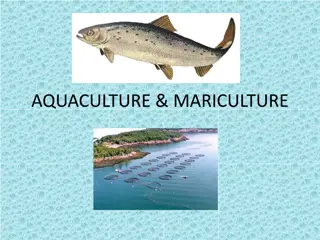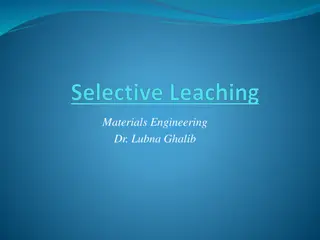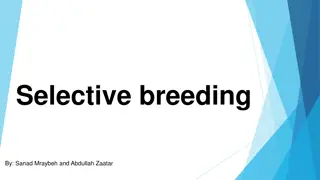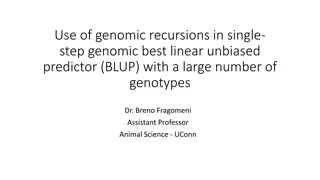Understanding Genetic Engineering and Selective Breeding
Genetic engineering involves changing the DNA in living organisms to create new traits, resulting in genetically modified organisms (GMOs). Techniques include artificial selection, cloning, gene splicing, and gel electrophoresis. Selective breeding is a form of artificial selection where animals with desired traits are mated to pass on important genes to the next generation. Examples include breeding dogs for specific purposes and breeding livestock for desired characteristics.
Download Presentation

Please find below an Image/Link to download the presentation.
The content on the website is provided AS IS for your information and personal use only. It may not be sold, licensed, or shared on other websites without obtaining consent from the author. Download presentation by click this link. If you encounter any issues during the download, it is possible that the publisher has removed the file from their server.
E N D
Presentation Transcript
Genetic Engineering Genetic Engineering
Genetic engineering: Changing the DNA in living organisms to create something new. This organisms are called Genetically Modified Organism (GMO) Example: Bacteria that produce human insulin Genetically Modified organism are called transgenic organism; since genes are transferred from one organism to another.
Some genetic engineering techniques are as follows: 1. Artificial selection A. selective breeding B. hybridization C. inbreeding 2. Cloning 3. Gene splicing 4. Gel electrophoresis: analyzing DNA
1. artificial selection: breeders choose which organism to mate to produce offspring with desired traits. They cannot control what genes are passed. When they get offspring with the desired traits, the maintain them. Three types of artificial selection: A. selective breeding B. hybridization C. inbreeding
A. Selective breeding: when animals with desired characteristics are mated to produce offspring with those desired traits. Passing of important genes to next generation. Example: Champion race horses, cows with tender meat, large juicy oranges on a tree.
For example people breed dogs for specific purposes. Dachshund were once bred to hunt badgers and other burrowing animals. They must be small to fit into the animals hole in the ground.
Selective breeding occurs when you choose the best male and female to breed. This allows you to fine tune and control the traits The offspring or babies will then have the best traits. Then you continue to breed those organism with the best traits, those traits will be maintained.
Examples of selective breeding: Angus cows are bred to increase muscle mass so that we get more meat, Egg-Laying Hen- produces more eggs than the average hen
B. Hybridizations: two individuals with unlike characteristics are crossed to produce the best in both organisms. Example: Luther Burbank created a disease resistant potato called the Burbank potato. He crossed a disease resistant plant with one that had a large food producing capacity. Result: disease resistant plant that makes a lot of potatoes.
Other Examples of hybridization: 1. Liger: lion and tiger mix
2. Grape + apple= grapple. The fruit tastes like grapes and looks like apple.
C. Inbreeding breeding of organism that genetically similar to maintain desired traits. Dogs breeds are kept pure this way. Its how a Doberman remains a Doberman. It keeps each breed unique from others. Risk: since both have the same genes, the chance that a baby will get a recessive genetic disorder is high. Risks: blindness, joint deformities.
Variation: difference between individuals of a species. The differences are in the genes but we see the physical differences. For example: Some humans have blond hair and some have brown. This is a variation among humans. Some finches have short beaks, some have long beaks. Inbreeding decreases variations.
2. Cloning: creating an organism that is an exact genetic copy of another. There are human clones in our school. identical twins are naturally created clones. Clone: group of cells or organisms that are genetically identical as a result of asexual reproduction They will have the same exact DNA as the parent.
How is cloning done? A single cell is removed from a parent organism. An entire individual is grown from that cell. Remember one cell has all the DNA needed to make an entire organism. Each cell in the body has the same DNA, but cells vary because
Dolly: Dolly was the first mammal cloned. She had the same exact DNA as her mother and had no father. Cloning is a form of asexual reproduction. Only one genetic parent. http://content.tutorvista.com/biology_11/content/media/cloning.swf
Since Dolly, cats and other organisms have been cloned. The cat that was cloned had the same exact DNA but different color fur than the mother. How can this be? Environment plays a huge part in the way organisms develop.
How could you clone a human? Step 1: An egg is removed from a female human Eggs are haploid: 23 chromosomes. The nucleus of the egg is removed and is thrown away. 23 EGG CELL
Step 2: A body cell is removed from another person. The nucleus of the body cell is removed Body cells are diploid: 46 chromosomes. 46 Body Cell
Step 3: The nucleus of the diploid body cell is put into the egg. This egg no longer needs to be fertilized since it has all 46 chromosomes. 46 EGG CELL
Step 4: The egg is then charged with electricity to start mitosis. Step 5: Its then put into a surrogate mother so it can grow. Its going to be genetically identical to the parent of the body cell. But it will be a baby. Plants and animals can be cloned.
Click and clone http://learn.genetics.utah.edu/content/tech/cloni ng/clickandclone/
Benefits of cloning: 1. you can make exact copies of organisms with strong traits. 2. Increase food supply 3. Medical purposes: clone organs for transplants. 4. Bring back or Stop species from going extinct. Saber Tooth Tiger extinct
Risks of cloning: 1. Decreases genetic diversity 2. If one of your clones gets a disease, they all get it: same immune system. 3. Inefficient: high failure rate: 90%+ 4. Expensive
3. Gene splicing: DNA is cut out of one organism and put into another organism A trait will be transferred from one organism to another. For example: the human insulin gene can be removed from a human cell. It can be put into a bacterial cell. The bacterial will now make human insulin.
This picture represents gene splicing. However, DNA is much smaller. Its done with high tech lab equipment since DNA, is too small to hold or see without a microscope. The red piece the woman is holding is an insulin gene from a human being. It is being combined with DNA from a bacteria. Creates recombinant DNA, something that has never existed before.
Benefits: insulin is cheaper There are no side effects because it is human insulin. We once used pig insulin but there are side effects and it more expensive.
1. Transgenic (GMO) animals: genes inserted into animals so they produce what humans need. Why?: A way to improve the food supply: A. Transgenic cows: gene inserted to increase milk production.
B. Spider goat: gene from spider inserted into goat. Goats makes silk of the spider web in their milk. Flexible, stronger than steel. Used in bullet proof jackets.
C. Glow-in-the-dark cats Scientist used a virus to insert DNA from jellyfish The gene made the cat produce a fluorescent protein in its fur.
2. Transgenic bacteria: gene inserted into bacteria so they produce things humans need. For example: insulin and clotting factors in blood are now made by bacteria.
3. Transgenic plants: plants are given genes so they meet human needs. A. Transgenic corn: given a gene so corn produces a natural pesticide. Now they don t have to be sprayed with cancer causing pesticides. 25% of all corn is like this.
B. Venomous cabbage gene from a scorpion tails inserted into cabbage. Cabbage now produces that chemical. Why? Limit pesticide use while still preventing insects from damaging crops. Corporations state the toxin is modified so it isn t harmful to humans.
C. Banana vaccines virus is injected into a banana, the virus DNA becomes part of the plant. As the plant grows, it produces the virus proteins but not the disease part of the virus. When people eat a bite, their immune systems creates antibodies to fight the disease just like a traditional vaccine Vaccines for hepatitis and cholera
A virus is often used to deliver DNA. In the movie I Am Legend, A healthy gene was inserted into a virus. The virus invaded the cancer cells and inserts the healthy gene to cure cancer. Worked at first but the virus mutated and became deadly. This is being attempted in real life.
Gene therapy: when disease causing genes are cut out and good gene are inserted. Restriction enzymes are used to cut out bad genes. Viruses are used to insert good genes. Not approved for human use yet. Some possible side effects.


